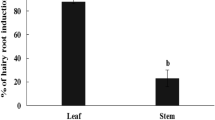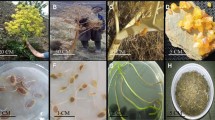Abstract
Picrorhiza kurroa Royle ex Benth. is an endangered plant producing various compounds of medicinal importance. Hairy roots of P. kurroa were obtained following cocultivation of shoot tip explants with Agrobacterium rhizogenes strains A 4 and PAT 405. Bacterial strain A 4 appeared to be better than the strain PAT 405 in terms of both growth of respective hairy root cultures and secondary metabolite production. The optimal growth of both the hairy root cultures occurred on half-strength semisolid medium with 3% sucrose. Picrotin and picrotoxinin from the roots of wild type field grown plants were compared with 8-week-old hairy root cultures induced by the A 4 and PAT 405 strains of A. rhizogenes. Picrotin and picrotoxinin content were evaluated in hairy root cultures as well as roots of field grown plant of P. kurroa. In terms of the production of picrotin and picrotoxinin, the A 4 induced hairy roots appeared to be a better performer than the PAT 405 induced hairy root cultures. The picrotin and picrotoxinin content was highest in 8-week-old A 4 induced hairy roots (8.8 μg/g DW and 47.1 μg/g DW, respectively). Rapid growth of the hairy roots of P. kurroa with in vitro secondary metabolite production potential may offer an attractive alternative to the exploitation of this endangered plant species.




Similar content being viewed by others
References
Choi PS, Kim YD, Choi KP, Chung HJ, Choi DW, Liu JR (2004) Plant regeneration from hairy-root cultures transformed by infection with Agrobacterium rhizogenes in Catharanthus roseus. Plant Cell Rep 22:828–831
Doyle JJ, Doyle JL (1987) A rapid DNA isolation procedure for small quantities of fresh leaf tissue. Phytochem Bull 19:11–15
Dubey NK, Kumar R, Tripathi P (2004) Global promotion of herbal medicine: India’s opportunity. Curr Sci 86:37–41
Giri A, Ravindra ST, Dhingra V, Narsu ML (2001) Influence of different strains of Agrobacterium rhizogenes on induction of hairy roots and artemisin production in Artimisia annua. Curr Sci 81:378–382
Guillon S, Tremouillaux-Guiller J, Pati PK, Rideau M, Gantet P (2006a) Harnessing the potential of hairy roots: dawn of a new era. Trends Biotechnol 24:403–409
Guillon S, Tremouillaux-Guiller J, Pati PK, Rideau M, Gantet P (2006b) Hairy root research: recent scenario and exciting prospects. Curr Opin Plant Biol 9:341–346
Hooykass PJJ, Klapwijk PM, Nuti PM, Shilperoot RA, Rorsch A (1977) Transfer of the Agrobacterium tumefaciens Ti-plasmid to a virulent Agrobacterium and Rhizobium explanta. J Gen Microbiol 98:477–487
Hu Z, Du M (2006) Hairy roots and its application in plant genetic engineering. J Integr Plant Biol 48:121–127
Hussain A (1984) Conservation of genetic resources of medicinal plants in India. In: Jain SK (ed) Conservation of tropical plant resources. Botanical Survey of India, Howrah, pp 110–117
Karmarkar SH, Keshavachandran R (2001) Genetic transformation and hairy root induction in Holostmma adakodien K. Schum—a vulnerable medicinal plant. Indian J Exp Biol 39:1263–1267
Kirtikar KR, Basu BD (1984) Indian medicinal plants, vol Vol III. Bishen Singh Mahendra Pal Singh, Dehradun, pp 1824–1826
Kittipongpatana N, Hock RS, Porter JR (1998) Production of solasodine by hairy root, callus, and cell suspension cultures of Solanum aviculare Forst. Plant Cell Tiss Org Cult 52:133–143
Kumar S, Singh J, Shah NC, Ranjan V (1997) Picrorhiza kurroa. In: Sharma A, Kumar A, Tewari R, Hasan SA (eds) Indian Medicinal and aromatic plants facing genetic erosion. CIMAP, Lucknow, pp 169–172
Pavlov A, Georgiev V, Ilieva M (2005) Betalain biosynthesis by red beet (Beta vulgaris L.) hairy root culture. Process Biochem 40:1531–1533
Purohit H, Nautiyal BP, Nautiyal MC (2008) Interpopulation variation in Picrorhiza kurroa Royle ex Benth-Step towards identifying genetic variability and elite strains for crop improvement study. Am J Plant Physiol 3(4):154–164
Ramchandra Rao S, Ravishankar GA (2002) Plant cell cultures: chemical factories of secondary metabolites. Biotech Adv 20:101–153
Samant SS, Dhar U, Palni LMS (1998) Medicinal plants of Indian Himalaya: diversity, distribution and potential value. Gyanodaya Prakashan, Nainital, p 163
Tepfer D (1984) Transformation of several species of higher plants by Agrobacterium rhizogenes: sexual transmission of the transformed genotype and phenotype. Cell 37:959–967
Thakur RS, Puri HS, Hussain A (1989) Major medicinal plants of India. CIMAP, Lucknow, pp 404–407
Verma PC, Rahman L, Negi AS, Jain DC, Khanuja SPS, Banerjee S (2007) Agrobactrium rhizogenes mediated transformation of Picrorhiza kurroa Royle ex Benth.: establishment and selection of superior hairy root clone. Plant Biotechnol Rep 1:169–174
Acknowledgments
Financial assistance from UCOST, Government of Uttarakhand is gratefully acknowledged. Authors are thankful to the Director, GBPIHED, Almora, Uttarakhand.
Author information
Authors and Affiliations
Corresponding author
Additional information
Communicated by S. Lewak.
Rights and permissions
About this article
Cite this article
Mishra, J., Bhandari, H., Singh, M. et al. Hairy root culture of Picrorhiza kurroa Royle ex Benth.: a promising approach for the production of picrotin and picrotoxinin. Acta Physiol Plant 33, 1841–1846 (2011). https://doi.org/10.1007/s11738-011-0724-x
Received:
Revised:
Accepted:
Published:
Issue Date:
DOI: https://doi.org/10.1007/s11738-011-0724-x




